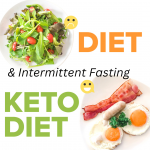Summary of the Article
- Understand the relationship between chrononutrition and circadian rhythm, and how they impact blood sugar balance and weight loss.
- Discover the role of nutrient-dense foods in chrononutrition, including their importance and examples of such foods.
- Learn how chrononutrition and circadian rhythm influence blood sugar levels and the crucial role of nutrient-dense foods in maintaining balance.
- Explore practical strategies for implementing chrononutrition and circadian rhythm, including tips for identifying your body’s rhythm and incorporating nutrient-dense foods at the right times.
Understanding Chrononutrition & Circadian Rhythm
Definition of Chrononutrition
Chrononutrition is a growing field of nutritional science that studies the interplay between our eating patterns and our biological clocks. It operates on the principle that not only what we eat but also when we eat matters significantly for our overall health.
Research has shown that extending the daily eating period can contribute to the onset of chronic diseases. This is where the concept of Time-Restricted Eating (TRE), a specific form of chrononutrition, comes into play. TRE is a dietary approach that especially limits the daily food window, aligning it more closely with our natural circadian rhythm to enhance health markers1.
Explanation of Circadian Rhythm
The circadian rhythm, often referred to as our “body clock,” is a natural, internal system designed to regulate feelings of sleepiness and wakefulness over a 24-hour period. It is influenced by environmental cues, like sunlight and temperature, but it also has a significant effect on various physiological processes in our bodies, including digestion, metabolism, and hormone production.
Our circadian rhythm not only determines our sleep and wake cycles, but it also impacts our feeding times. Our bodies have evolved to operate on a schedule where we eat during daylight hours and fast during the night. This schedule aligns with our metabolic processes, which are primed to break down and utilize food most efficiently during the day. By eating in sync with our circadian rhythm, we can optimize our digestion and metabolism, leading to improved health outcomes.
Remarkably, chrononutrition goes beyond mere caloric intake. It’s been observed that Time-Restricted Eating can lead to benefits like weight loss and improved metabolic health, even without a reduction in caloric intake. This suggests that there’s an intrinsic effect at play, one based on the realignment of feeding with our circadian clock2.
Understanding the principles of chrononutrition and the circadian rhythm can be an invaluable tool in our quest for better health. By aligning our eating patterns with our body’s natural rhythms, we can unlock a host of potential health benefits, from better blood sugar control to effective weight management.
The Role of Nutrient-Dense Foods in Chrononutrition
Importance of Nutrient-Dense Foods
Nutrient-dense foods hold a critical role in chrononutrition. These foods pack a high concentration of essential nutrients relative to their caloric content. They are often rich in vitamins, minerals, complex carbohydrates, lean protein, and healthy fats. Consuming nutrient-dense foods provides the body with the necessary resources it needs to function optimally and repair itself.
Chrononutrition emphasizes not just the timing of meals but also the quality of the food consumed. By incorporating nutrient-dense foods into our diets, we ensure that our bodies receive the proper fuel at the right times to harmonize with our natural circadian rhythm. This synchronization can lead to improved digestion, optimized metabolism, and overall better health outcomes.
Examples of Nutrient-Dense Foods
Incorporating nutrient-dense foods into our diets is simpler than we might think. Here are a few examples:
- Whole Grains: Foods like brown rice, quinoa, and oats are high in fiber and help to regulate blood sugar levels throughout the day.
- Lean Proteins: Foods like fish, poultry, and legumes are packed with protein, essential for repairing body tissues and maintaining a healthy immune system.
- Fruits and Vegetables: These food groups offer a wealth of vitamins and minerals, as well as fiber, crucial for healthy digestion.
- Healthy Fats: Avocados, nuts, and seeds provide healthy fats, which are essential for nutrient absorption and brain health.
By intentionally including these nutrient-dense foods in our diet, and timing their intake according to our body’s natural rhythm, we can support our health in a holistic and sustainable way, maximizing the benefits of chrononutrition.
Chrononutrition, Circadian Rhythm, and Blood Sugar Balance
How Chrononutrition and Circadian Rhythm Affect Blood Sugar Levels
Our body’s circadian rhythm doesn’t only dictate when we sleep or wake; it also significantly influences our metabolism, including how we manage blood sugar levels. Chrononutrition plays into this by offering a way to align our eating patterns with our body’s natural rhythm, helping to optimize our metabolic processes.
When we eat in harmony with our circadian rhythm, we promote more stable blood sugar levels throughout the day. For instance, our insulin sensitivity is naturally higher in the morning, meaning our bodies are better equipped to process carbohydrates and maintain balanced blood sugar levels. Eating a nutrient-dense, carbohydrate-rich breakfast can make the most of this metabolic advantage.
Role of Nutrient-Dense Foods in Balancing Blood Sugar
Nutrient-dense foods play a critical role in balancing blood sugar levels. Foods high in fiber, such as fruits, vegetables, and whole grains, slow the absorption of sugar into our bloodstream, preventing spikes and crashes in blood sugar levels. This slow release of energy helps maintain a steady blood sugar level, reducing the risk of insulin resistance and diabetes.
Moreover, lean proteins and healthy fats also contribute to blood sugar balance. They provide satiety, reducing cravings for sugary snacks that can disrupt blood sugar balance.
By understanding and respecting our body’s natural circadian rhythm and pairing that with the right food choices, we can effectively balance our blood sugar levels. This balance is crucial for maintaining energy levels, preventing disease, and supporting overall health.
Weight Loss through Chrononutrition & Nutrient-Dense Foods
Connection between Chrononutrition, Circadian Rhythm, and Weight Loss
Chrononutrition, in conjunction with our body’s natural circadian rhythm, can be a powerful tool for weight loss. When we align our eating patterns with our circadian rhythm, we optimize our metabolic processes, promoting efficient calorie utilization and fat burning.
Research has shown that time-restricted eating, a form of chrononutrition, can lead to weight loss even without a reduction in overall caloric intake. By restricting the eating window to a specific period, such as 8-10 hours per day, we provide our body with ample time to process and burn stored energy.
Additionally, synchronizing nutrient-dense food choices with our circadian rhythm can enhance weight loss efforts. These foods provide essential nutrients while offering satiety and reducing cravings. The combination of nutrient-dense foods and an optimized eating schedule can help curb excessive calorie intake, improve metabolic function, and support healthy weight management.
How Nutrient-Dense Foods Contribute to Weight Loss
Nutrient-dense foods are a cornerstone of successful weight loss. They offer a multitude of benefits that directly contribute to shedding excess pounds. Firstly, these foods are rich in essential nutrients, ensuring that our body receives the necessary nourishment while reducing the risk of nutrient deficiencies.
Furthermore, nutrient-dense foods are often low in calories but high in volume and fiber. This combination promotes satiety, helping us feel fuller for longer periods and reducing the likelihood of overeating. By incorporating more fruits, vegetables, lean proteins, and whole grains into our diet, we can control our calorie intake while still satisfying our nutritional needs.
Incorporating nutrient-dense foods into a well-designed chrononutrition plan enhances weight loss efforts by providing the body with the necessary fuel and nutrients for optimal metabolic function. Combined with an aligned eating schedule, nutrient-dense foods support a healthy weight loss journey that is sustainable and nourishing for the body.
Practical Strategies for Implementing Chrononutrition & Circadian Rhythm
Tips for Identifying Your Body’s Circadian Rhythm
Understanding your body’s circadian rhythm is crucial for implementing effective chrononutrition strategies. To identify your natural rhythm, pay attention to your energy levels, sleep patterns, and hunger cues throughout the day. Notice when you feel most alert and energetic, as well as when you naturally start to wind down in the evening.
It can also be helpful to keep a sleep diary to track your sleep-wake cycle and note any variations or patterns. Additionally, consider consulting with a healthcare professional or sleep specialist who can provide further guidance in identifying your circadian rhythm.
How to Align Your Eating Patterns with Your Circadian Rhythm
Once you’ve identified your body’s circadian rhythm, the next step is aligning your eating patterns accordingly. Start by establishing a regular eating schedule that reflects your natural peaks and troughs of energy. For example, if you tend to feel most energetic in the morning, aim to have a nutrient-dense, balanced breakfast to kickstart your day.
Additionally, consider practicing time-restricted eating, where you limit your eating window to specific hours of the day. This approach can help synchronize your eating patterns with your circadian rhythm and promote efficient digestion and metabolism.
Suggestions for Incorporating Nutrient-Dense Foods at the Right Times
To maximize the benefits of chrononutrition, it’s essential to incorporate nutrient-dense foods at the right times of the day. Here are some practical suggestions:
- Start your day with a breakfast rich in complex carbohydrates, fiber, and protein to provide sustained energy throughout the morning.
- Include a variety of colorful fruits and vegetables in your meals and snacks to ensure a wide range of nutrients.
- Opt for lean sources of protein, such as poultry, fish, legumes, and tofu, to support muscle health and promote satiety.
- Choose whole grains, such as quinoa, brown rice, and oats, as a source of complex carbohydrates and fiber.
- Incorporate healthy fats from sources like avocados, nuts, and olive oil to support nutrient absorption and provide satiety.
By aligning your eating patterns with your circadian rhythm and prioritizing nutrient-dense foods, you can optimize your chrononutrition journey and support your overall health and well-being.
In Summary
In summary, understanding the relationship between chrononutrition, circadian rhythm, and our overall health is key to promoting balanced blood sugar levels and achieving weight loss goals. By harnessing the power of nutrient-dense foods and aligning our eating patterns with our body’s natural rhythms, we can optimize our well-being.
Throughout this article, we have explored the definition of chrononutrition and circadian rhythm, highlighting their importance in regulating various physiological processes, including blood sugar balance and weight management. We have also discussed the role of nutrient-dense foods in supporting these goals, providing examples of foods rich in essential nutrients.
To implement these strategies in your daily life, it is crucial to identify your body’s circadian rhythm and adapt your eating patterns accordingly. Pay attention to your energy levels, sleep patterns, and hunger cues to establish a personalized routine. Incorporate nutrient-dense foods at the right times, ensuring a balanced and diverse diet.
I encourage you to take the knowledge and strategies shared in this article and apply them to your own life. Embrace the power of chrononutrition and circadian rhythm to achieve optimal health, balanced blood sugar levels, and sustainable weight loss. Remember, small changes can lead to significant results, so start implementing these practices today and enjoy the benefits of a well-nourished body and mind.
Together, let’s embark on this journey towards better health and well-being through the power of chrononutrition and nutrient-dense foods.
Frequently Asked Questions
Q: How does chrononutrition affect blood sugar balance and weight loss? A: Chrononutrition plays a crucial role in blood sugar balance and weight loss by aligning our eating patterns with our body’s natural circadian rhythm. By consuming nutrient-dense foods at the right times, we can optimize insulin sensitivity, regulate metabolism, and promote weight loss.
Q: What are some examples of nutrient-dense foods mentioned in the article? A: Nutrient-dense foods include leafy greens, colorful vegetables, lean proteins, whole grains, nuts, seeds, and healthy fats like avocados and olive oil. These foods are rich in vitamins, minerals, fiber, and antioxidants, providing essential nourishment for our bodies.
Q: How can I identify my body’s circadian rhythm? A: Pay attention to your energy levels, sleep patterns, and natural hunger cues. Notice when you feel most alert and energized during the day and when you naturally start to feel tired in the evening. This can help you identify your body’s circadian rhythm.
Q: Are there any practical strategies to align eating patterns with my circadian rhythm? A: Yes! Try to have your largest meals during your body’s natural peak energy times and consume lighter meals or snacks during the evening and night when your body naturally winds down. This can help optimize digestion, nutrient absorption, and overall metabolic function.
Q: Can nutrient-dense foods help with weight loss? A: Absolutely! Nutrient-dense foods provide essential nutrients while being lower in calories compared to processed and less nutritious options. They can help keep you satiated, support your overall health, and promote sustainable weight loss when combined with a balanced diet and regular physical activity.
Q: Is chrononutrition suitable for everyone? A: Chrononutrition can benefit individuals of all ages and lifestyles. However, it’s important to consult with a healthcare professional or registered dietitian, especially if you have any specific health concerns or medical conditions.
Q: Are there any potential challenges in implementing chrononutrition and circadian rhythm strategies?A: Adapting to a new eating pattern and aligning with your circadian rhythm may require some adjustments. It may take time to identify your body’s natural rhythm and find the right balance of nutrient-dense foods. However, the long-term benefits of improved blood sugar balance, weight loss, and overall health make it worthwhile.
Q: How long does it take to see results with chrononutrition and nutrient-dense foods?
A: The timeline for seeing results may vary depending on individual factors, such as metabolism, activity level, and overall health. Consistency and commitment to a balanced approach are key. With time, you can expect to experience improved energy levels, better blood sugar control, and gradual weight loss.
Q: Can I incorporate chrononutrition and circadian rhythm strategies alongside other dietary approaches or weight loss programs?
A: Yes, chrononutrition and circadian rhythm strategies can complement other dietary approaches or weight loss programs. By focusing on nutrient-dense foods and aligning your eating patterns, you can enhance the effectiveness of any approach and support your overall well-being.
Q: What is the call to action in this article?
A: Embrace the power of chrononutrition and circadian rhythm to optimize your health, balance blood sugar, and promote weight loss. Start implementing the practical strategies discussed in this article today and witness the positive impact on your well-being. Are you ready to unlock the potential of nutrient-dense foods and harmonize your eating patterns with your body’s natural rhythm?










